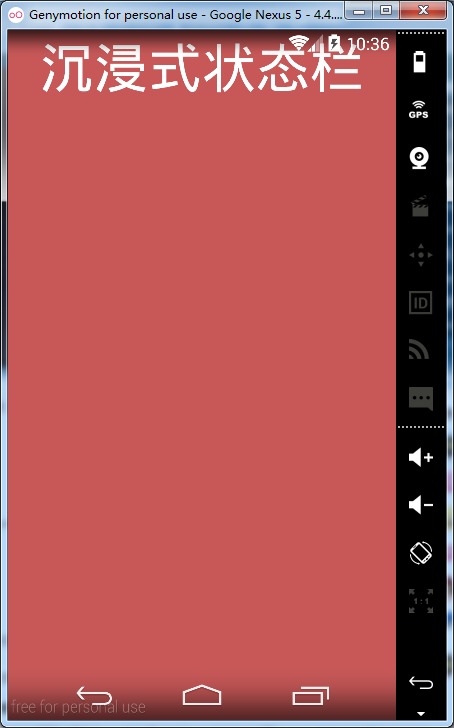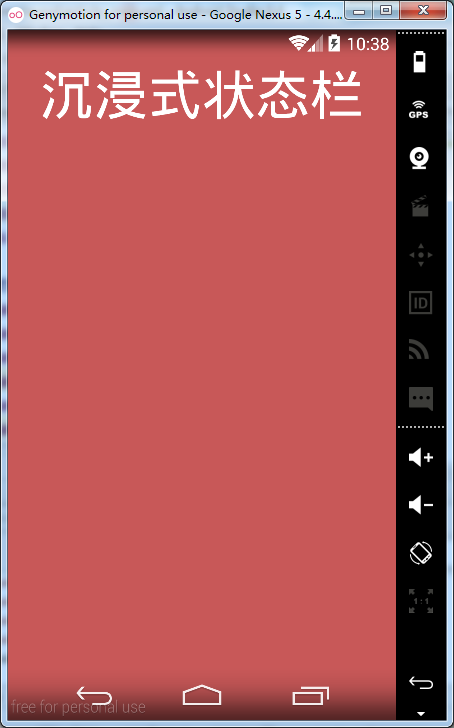相信用过iPhone的人,都会觉得iPhone的那种沉浸式状态栏比Android那种硬邦邦的黑色状态栏要好看多了,以前的Android版本是不能进行修改了,或者说修改比较麻烦,但是4.4之后我们可以非常简单的进行状态栏颜色的修改了。只需要简单的几行的代码就可以进行修改了。
首先我们来看看效果:
实现状态栏颜色修改有两种方法可以实现:
第一种:
getWindow().addFlags(WindowManager.LayoutParams.FLAG_TRANSLUCENT_STATUS);
将状态栏设置为透明,然后在你的根布局文件里面设置一个背景颜色,这样就可以实现沉浸式状态栏了,不过我们会看到这样的效果:

你会发现布局已经填充到状态栏里面了,这样是因为我们设置透明以后默认就不会自动间距状态栏的高度了,这个时候我们只需要在你的根布局上面添加这两行代码:
android:fitsSystemWindows="true"
android:clipToPadding="true"就可以了,好,我们再运行一下:
不过,在5.0的模拟器上面用这种方法进行状态栏设置时,是无效的,不是知道是不是模拟器的问题,没有真机5.0的系统,测试不了。这里如果有测试过的朋友,可以在下面留言给我哦!
以上就是第一种方式状态栏设置颜色
第二种:
这种方式是利用github上面一个开源项目来实现的,地址不记得了,这里就不贴了,对不起原创啦!
先贴上代码:
/**
* Class to manage status and navigation bar tint effects when using KitKat
* translucent system UI modes.
*
*/
public class SystemBarTintManager {
static {
// Android allows a system property to override the presence of the navigation bar.
// Used by the emulator.
// See https://github.com/android/platform_frameworks_base/blob/master/policy/src/com/android/internal/policy/impl/PhoneWindowManager.java#L1076
if (Build.VERSION.SDK_INT >= Build.VERSION_CODES.KITKAT) {
try {
Class c = Class.forName("android.os.SystemProperties" );
Method m = c.getDeclaredMethod("get" , String.class);
m.setAccessible(true);
sNavBarOverride = (String) m.invoke(null, "qemu.hw.mainkeys" );
} catch (Throwable e) {
sNavBarOverride = null;
}
}
}
/**
* The default system bar tint color value.
*/
public static final int DEFAULT_TINT_COLOR = 0x99000000;
private static String sNavBarOverride;
private final SystemBarConfig mConfig;
private boolean mStatusBarAvailable;
private boolean mNavBarAvailable;
private boolean mStatusBarTintEnabled;
private boolean mNavBarTintEnabled;
private View mStatusBarTintView;
private View mNavBarTintView;
/**
* Constructor. Call this in the host activity onCreate method after its
* content view has been set. You should always create new instances when
* the host activity is recreated.
*
* @param activity The host activity.
*/
@TargetApi(19)
public SystemBarTintManager(Activity activity) {
Window win = activity.getWindow();
ViewGroup decorViewGroup = (ViewGroup) win.getDecorView();
if (Build.VERSION.SDK_INT >= Build.VERSION_CODES.KITKAT) {
// check theme attrs
int[] attrs = {android.R.attr.windowTranslucentStatus,
android.R.attr.windowTranslucentNavigation};
TypedArray a = activity.obtainStyledAttributes(attrs);
try {
mStatusBarAvailable = a.getBoolean(0, false );
mNavBarAvailable = a.getBoolean( 1, false);
} finally {
a.recycle();
}
// check window flags
WindowManager.LayoutParams winParams = win.getAttributes();
int bits = WindowManager.LayoutParams.FLAG_TRANSLUCENT_STATUS;
if ((winParams.flags & bits) != 0) {
mStatusBarAvailable = true;
}
bits = WindowManager.LayoutParams.FLAG_TRANSLUCENT_NAVIGATION;
if ((winParams.flags & bits) != 0) {
mNavBarAvailable = true;
}
}
mConfig = new SystemBarConfig(activity, mStatusBarAvailable, mNavBarAvailable);
// device might not have virtual navigation keys
if (!mConfig.hasNavigtionBar()) {
mNavBarAvailable = false;
}
if (mStatusBarAvailable) {
setupStatusBarView(activity, decorViewGroup);
}
if (mNavBarAvailable) {
setupNavBarView(activity, decorViewGroup);
}
}
/**
* Enable tinting of the system status bar.
*
* If the platform is running Jelly Bean or earlier, or translucent system
* UI modes have







 本文介绍了在Android 4.4及更高版本中如何实现沉浸式状态栏,包括两种方法:通过设置透明状态栏并调整布局,以及使用开源库。虽然在Android 5.0模拟器上第一种方法可能无效,但第二种方法提供了更好的扩展性,适合作为BaseActivity的基础。作者期待未来Android能提供更简单的API来直接修改状态栏颜色。
本文介绍了在Android 4.4及更高版本中如何实现沉浸式状态栏,包括两种方法:通过设置透明状态栏并调整布局,以及使用开源库。虽然在Android 5.0模拟器上第一种方法可能无效,但第二种方法提供了更好的扩展性,适合作为BaseActivity的基础。作者期待未来Android能提供更简单的API来直接修改状态栏颜色。


 最低0.47元/天 解锁文章
最低0.47元/天 解锁文章















 256
256

 被折叠的 条评论
为什么被折叠?
被折叠的 条评论
为什么被折叠?








